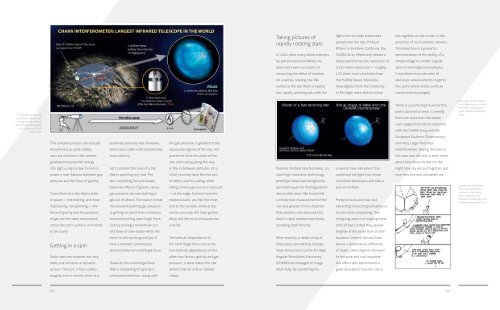Sol Lucet Omnibus - ESO
Sol Lucet Omnibus - ESO
Sol Lucet Omnibus - ESO
- TAGS
- lucet
- omnibus
- www.eso.org
You also want an ePaper? Increase the reach of your titles
YUMPU automatically turns print PDFs into web optimized ePapers that Google loves.
The CHARA Array took<br />
a picture of Altair, even<br />
though it’s as difficult<br />
as reading a newspaper<br />
at a distance of 160<br />
kilometres.<br />
This complex process can actually<br />
be summed up quite neatly:<br />
stars are machines that convert<br />
gravitational potential energy<br />
into light using nuclear fusion to<br />
power a near-balance between gas<br />
pressure and the force of gravity.<br />
If you think of a star that is static<br />
in space — not moving, and more<br />
importantly, not spinning — the<br />
force of gravity and the pressure<br />
of gas are the same everywhere<br />
across the star’s surface, so it tends<br />
to be round.<br />
Getting in a spin<br />
Static stars are however not very<br />
likely in a Universe as dynamic<br />
as ours. The Sun, in fact, rotates<br />
roughly once a month, which is a<br />
60<br />
positively leisurely rate. However,<br />
some stars rotate with substantially<br />
more alacrity.<br />
Let’s consider the case of a star<br />
that is spinning very fast. The<br />
two competing, but previously<br />
balanced effects of gravity versus<br />
gas pressure are now starting to<br />
get out of whack. The reason is that<br />
the outward-pushing gas pressure<br />
is getting an assist from a similarly<br />
outward-pushing centrifugal force.<br />
Just try pulling a hand mixer out<br />
of a bowl of cake batter while the<br />
mixer is still spinning and you’ll<br />
have a dramatic (and messy)<br />
demonstration of centrifugal force.<br />
However, this centrifugal force<br />
that is competing for gravity’s<br />
centripetal attention, along with<br />
the gas pressure, is greatest at the<br />
equatorial regions of the star, not<br />
present at all at the poles of the<br />
star, and scaling along the way<br />
in the in-between latitudes. As a<br />
child, you may have felt this sort<br />
of effect, and its scaling, while<br />
riding a merry-go-round or carousel<br />
— at the edge, furthest from the<br />
rotational axis, you felt the most<br />
pull to the outside, while at the<br />
centre, you may still have gotten<br />
dizzy, but felt no pull towards the<br />
outside.<br />
The latitude dependence of<br />
the centrifugal force versus the<br />
non-latitude dependence of the<br />
other two factors, gravity and gas<br />
pressure, is what makes the star<br />
deform into an oval or “oblate”<br />
shape.<br />
Taking pictures of<br />
rapidly rotating stars<br />
In 2001, after many failed attempts<br />
by astronomers worldwide, my<br />
team and I were successful in<br />
measuring the effect of rotation<br />
on a rapidly rotating star. We<br />
looked at the star Altair, a nearby<br />
hot, rapidly spinning star, with the<br />
Palomar Testbed Interferometer, an<br />
ultra-high resolution technology<br />
prototype telescope designed to<br />
test techniques for finding planets<br />
about other stars. We found that<br />
a simple size measurement of the<br />
star was greater in one direction<br />
than another, and deduced that<br />
Altair’s rapid rotation was finally<br />
revealing itself directly.<br />
More recently, a newer array of<br />
telescopes operated by Georgia<br />
State University’s Centre for High<br />
Angular Resolution Astronomy<br />
(CHARA) has managed to image<br />
Altair fully. By combining the<br />
light from six small telescopes<br />
spread over the top of Mount<br />
Wilson in southern California, the<br />
CHARA Array effectively creates a<br />
telescope that has the resolution of<br />
a 330-metre telescope — roughly<br />
130 times more resolution than<br />
the Hubble Space Telescope.<br />
Investigators from the University<br />
of Michigan were able to utilise<br />
a special new instrument that<br />
combined the light from those<br />
individual telescopes and take a<br />
picture of Altair.<br />
Pretty pictures are nice, but<br />
extracting interesting astrophysics<br />
is even more compelling. One<br />
intriguing aspect of imaging these<br />
sorts of stars is that they appear<br />
brighter at the poles than at their<br />
equators. Indeed, the star Altair<br />
shows a temperature difference<br />
of nearly 2000 degrees between<br />
its hot pole and cool equators;<br />
this effect tells astronomers a<br />
great deal about how the star is<br />
put together on the inside, in the<br />
presence of such extreme rotation.<br />
This detection is a powerful<br />
demonstration of the ability of a<br />
simple image to contain a great<br />
deal of meaningful astrophysics.<br />
It has taken many decades of<br />
telescope advancements to get to<br />
this point where stellar surfaces<br />
can be directly imaged!<br />
There is a promising future for this<br />
particular kind of work. Currently<br />
there are more than five dozen<br />
such targets that will be observed<br />
with the CHARA Array and the<br />
European Southern Observatory’s<br />
own Very Large Telescope<br />
Interferometer. Seeing the stars in<br />
this new way will tell us even more<br />
about how these markers in the<br />
night time sky are put together, and<br />
how they live and ultimately die.<br />
61<br />
An image of Altair (right)<br />
in comparison to a model<br />
(left) that incorporates<br />
rapid rotation and bright<br />
poles.<br />
A graphical illustration<br />
from xkcd.com of the<br />
confusion that often<br />
occurs between the<br />
fictitious centrifugal force<br />
and the centripetal force.

















